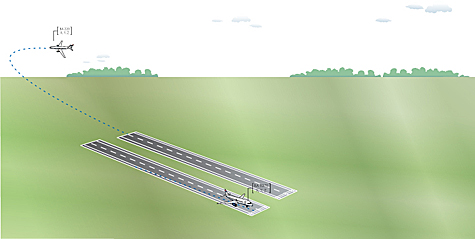| An important application of multilateration is its proven ability to provide greater safety while significantly increasing landing capacity. For airports with parallel runways, aircraft fly adjacent paths towards their separately assigned runways. But at many airports, the runways are too closely spaced for aircraft to safely fly adjacent to each other under instrument conditions. Aircraft are then “staggered” along each approach path with significant in-trail spacing between them, greatly reducing airport throughput, especially during inclement weather conditions. An early solution was the introduction of a dedicated, very accurate, electronically-scanned radar called the Precision Runway Monitor (PRM), which allowed adjacent approaches to runways spaced as close as 3,300 feet apart. However, the system’s acceptance was extremely limited due to its significant acquisition, installation and maintenance costs. While e-scan radars were cost-prohibitive, multilateration has now been demonstrated to meet and exceed radar specifications for precision runway monitoring, at substantially lower cost. MLAT PRM capacity gains have been reported to be 30 percent or more, especially during peak periods with adverse weather conditions. Further, environmental pressures and new zoning legislation are limiting airport expansion and may force new runways to be built within existing airport boundaries as closely spaced parallels to existing runways to accommodate rising future demands. With such immediate and clear economic benefits, multilateration PRM systems are expected to increase in the future, with systems currently being deployed at Beijing, Kuala Lumpur, Sydney and Detroit. | | Without PRM System Airports with closely spaced parallels must maintain staggered approaches, which decreases throughput, especially during peak periods and inclement weather.

With PRM System Airports with closely spaced parallels can maintain independent approaches, even during adverse weather conditions, which greatly improves capacity.
 |

